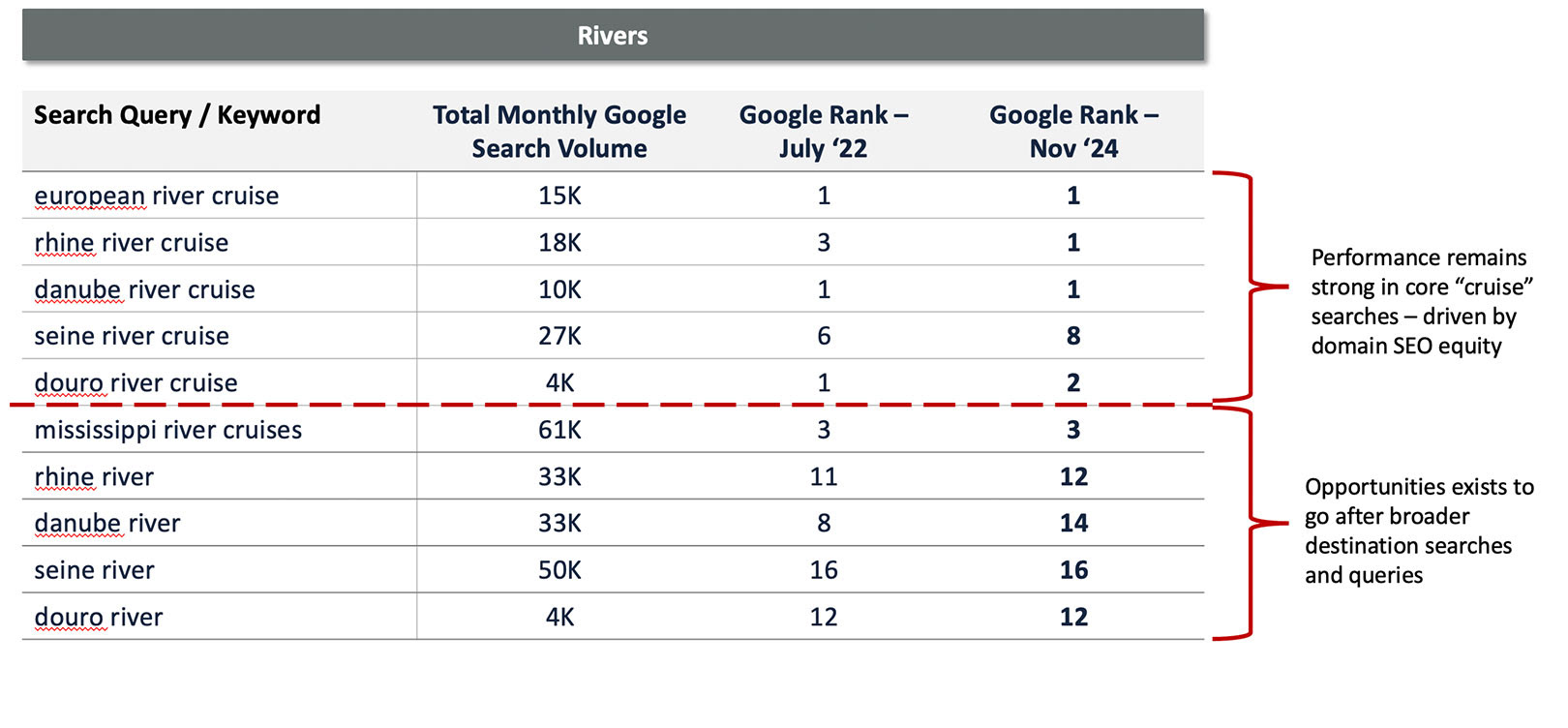New Website Search Experience
Role: UX Manager & Lead Designer
Collaborating with Product Designer, Digital Product Team & DEV Team
Collaborating with Product Designer, Digital Product Team & DEV Team
Problem
The search functionality and overall information retrieval experience on the platform presented significant challenges for users. This created frustration and led to increased reliance on customer support through calls and online chat.
The search functionality and overall information retrieval experience on the platform presented significant challenges for users. This created frustration and led to increased reliance on customer support through calls and online chat.
Goal
To enhance the search functionality and overall information retrieval experience on the platform, thereby reducing user frustration and decreasing reliance on customer support through calls and online chat by 50% within six months.
To enhance the search functionality and overall information retrieval experience on the platform, thereby reducing user frustration and decreasing reliance on customer support through calls and online chat by 50% within six months.
Key pain points included:
1. Lack of Intuitive Search: Users struggled to locate essential information such as contact details, cruise details, and itinerary inclusions, even for straightforward queries.
2. Destination-Based Itineraries Unavailable: The platform lacked a way to filter and search itineraries by destination, a critical feature for users planning their trips.
3. Limited Filtering and Sorting Options: Users had difficulty narrowing down search results due to insufficient filter and sort functionality, leading to overwhelming and irrelevant results.
4. Insufficient Resources for Different User Types: The platform did not cater effectively to the needs of new and returning guests, with limited access to tailored information or guides.
5. Inadequate Destination Information: Users lacked easy access to comprehensive details about destinations, making it harder to make informed decisions.
This misalignment between user needs and system capabilities resulted in a suboptimal user experience, hindering satisfaction and efficiency in trip planning. The challenge was to redesign the search and information architecture to better meet user expectations, reduce support dependency, and enhance overall usability.
2. Destination-Based Itineraries Unavailable: The platform lacked a way to filter and search itineraries by destination, a critical feature for users planning their trips.
3. Limited Filtering and Sorting Options: Users had difficulty narrowing down search results due to insufficient filter and sort functionality, leading to overwhelming and irrelevant results.
4. Insufficient Resources for Different User Types: The platform did not cater effectively to the needs of new and returning guests, with limited access to tailored information or guides.
5. Inadequate Destination Information: Users lacked easy access to comprehensive details about destinations, making it harder to make informed decisions.
This misalignment between user needs and system capabilities resulted in a suboptimal user experience, hindering satisfaction and efficiency in trip planning. The challenge was to redesign the search and information architecture to better meet user expectations, reduce support dependency, and enhance overall usability.
Existing Design
Outlining Our Starting Point
We identified our pain points and business goals to enhance key problem areas with effective solutions. We started by determining our KPIs based on these pain points, focusing on Search Categories and category touch-points to steer us in the right direction.
Visualization from Concept to
Post Launch Performance Measurement
Post Launch Performance Measurement
To improve the search experience, we will start with customer and target audience research to understand their needs, followed by a competitive analysis to identify best practices. We'll enhance topic and keyword research to ensure our content is optimized and relevant, and develop a clear strategy with set metrics and performance targets to track our progress.
Next, we'll create and launch high-quality content tailored to our users, and implement ongoing performance measurement and maintenance. This continuous feedback loop will help us optimize the user experience and keyword quality, making it easier for users to find what they need and reducing their reliance on customer support.
Pretty Fly For a Hi-Fi
After conducting thorough interviews with our past passengers, we moved forward with developing our Hi-Fi Design Concept. By maintaining open communication with our users, who provided valuable and constructive feedback, we were able to address their pain points effectively. This collaboration allowed us to create a more enriched search experience.
We incorporated SearchGPT, which continuously improves its accuracy by learning from user behaviors and frequently searched keywords. This intelligent system enhances the search functionality, making it smarter and more responsive to our users' needs over time.
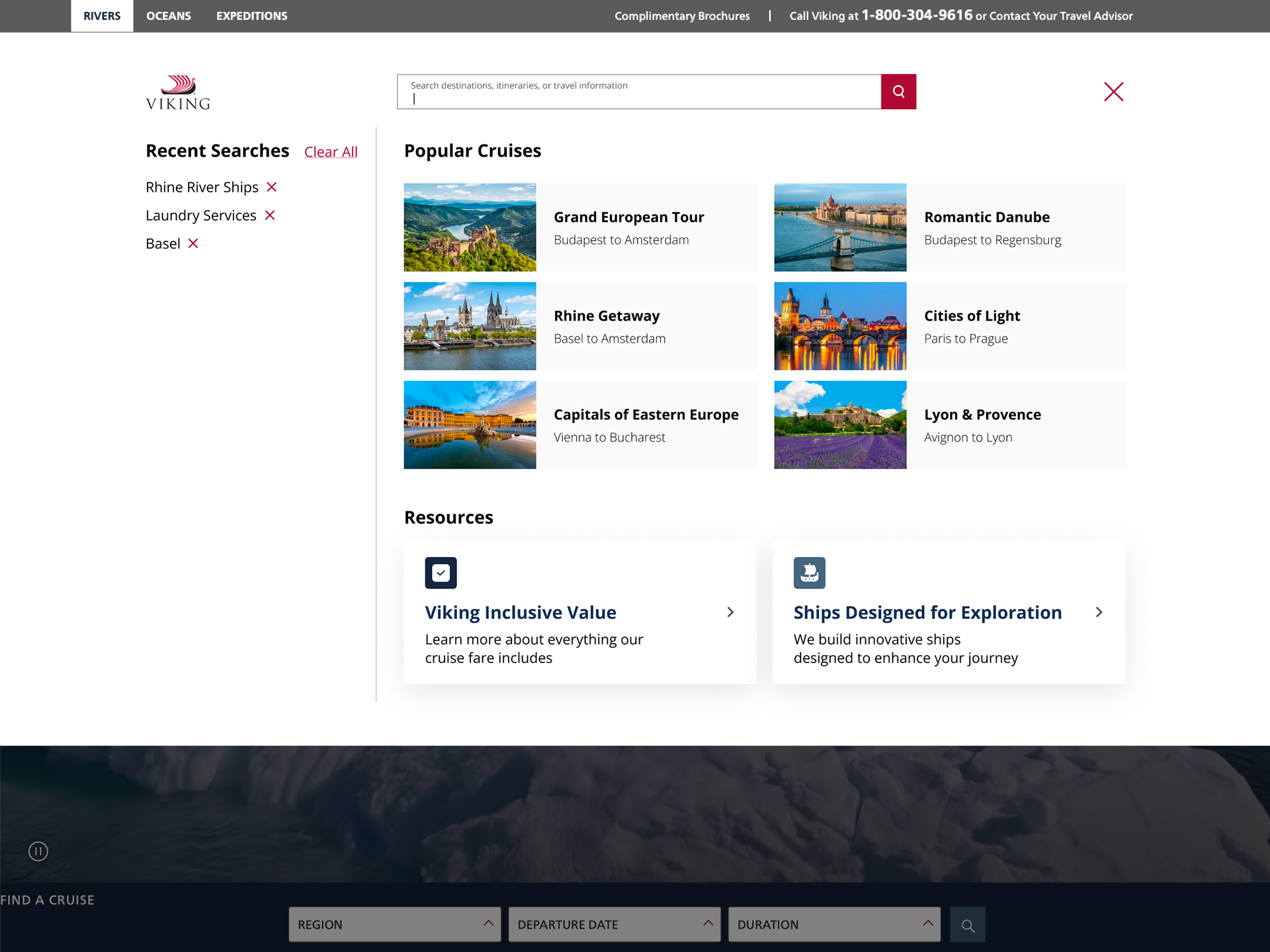
Intuitive & Suggestive Search Bar
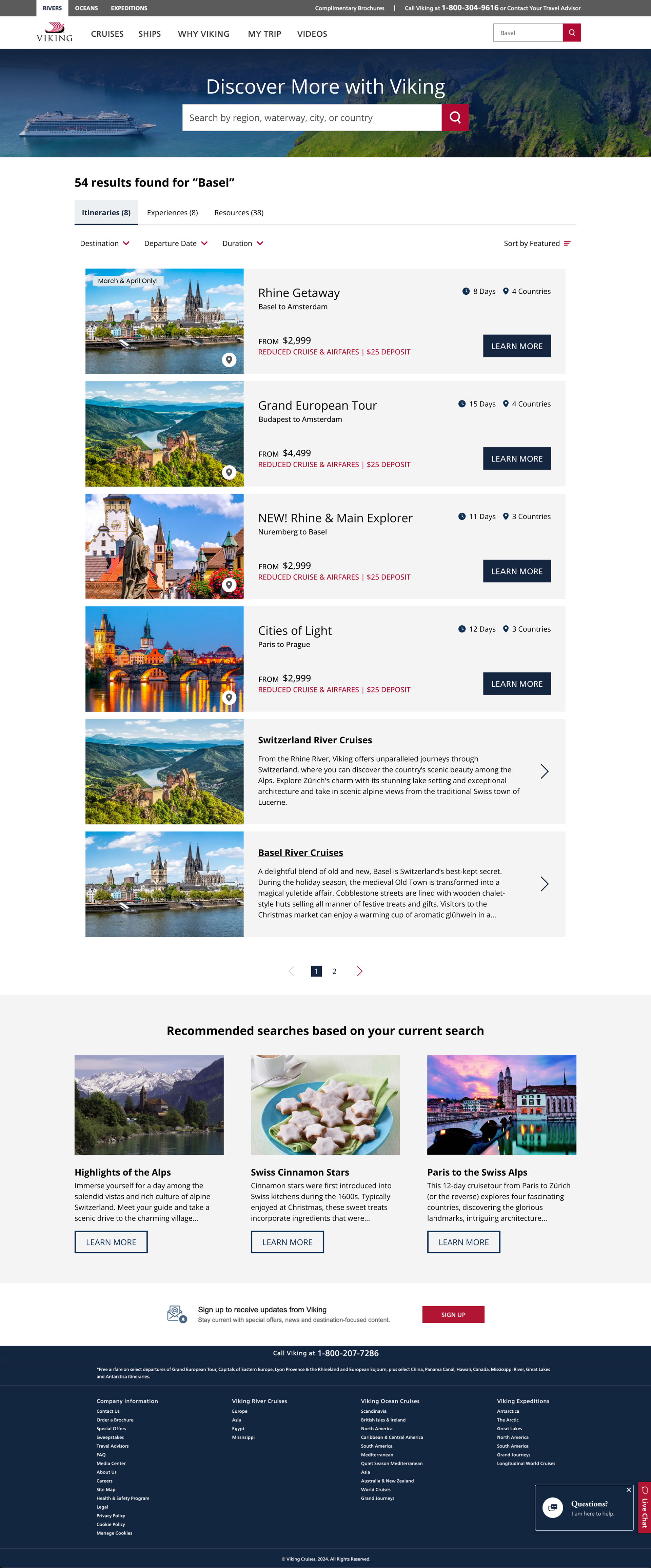
Itineraries Based Results
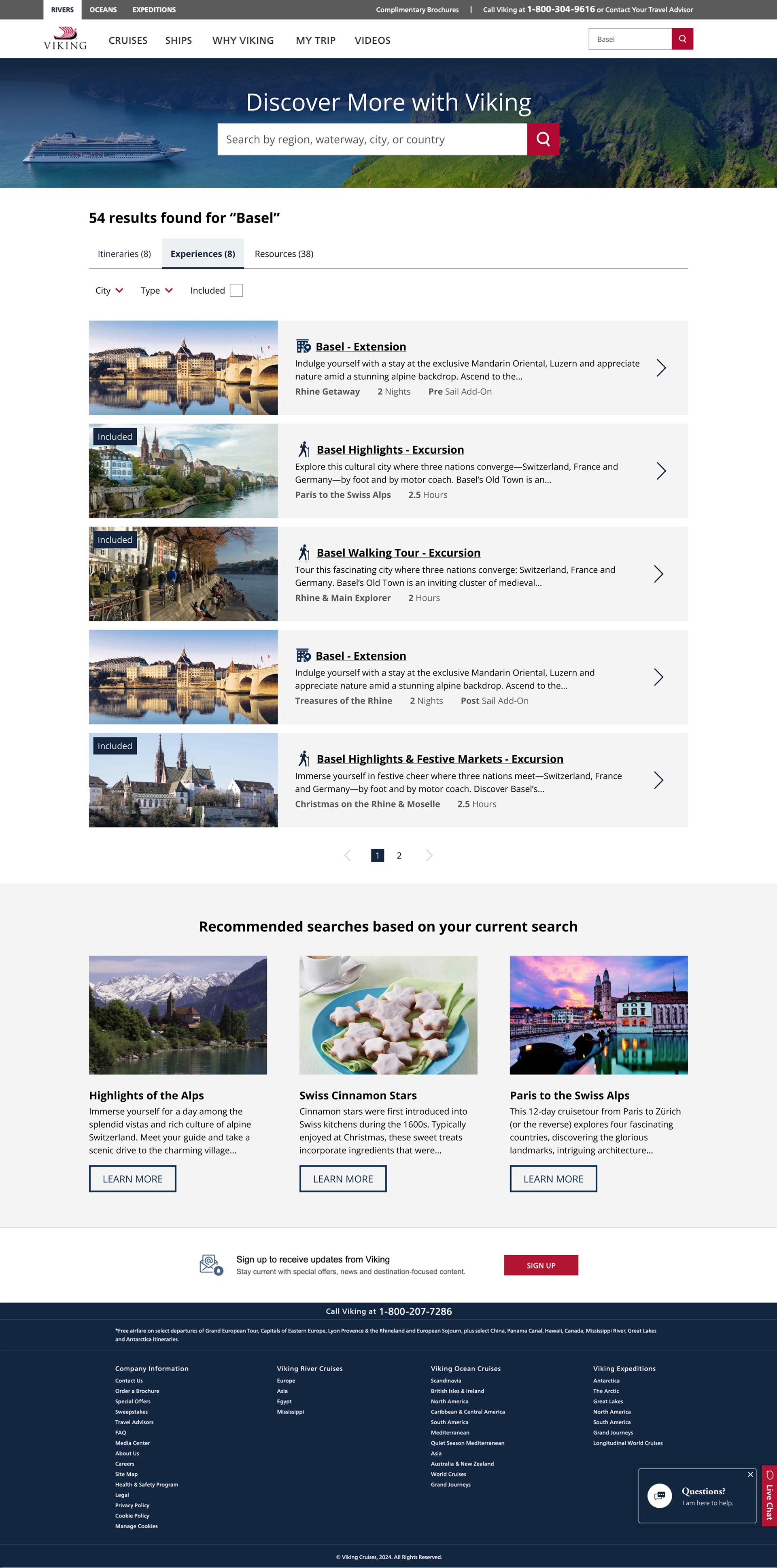
Experiences Based Results
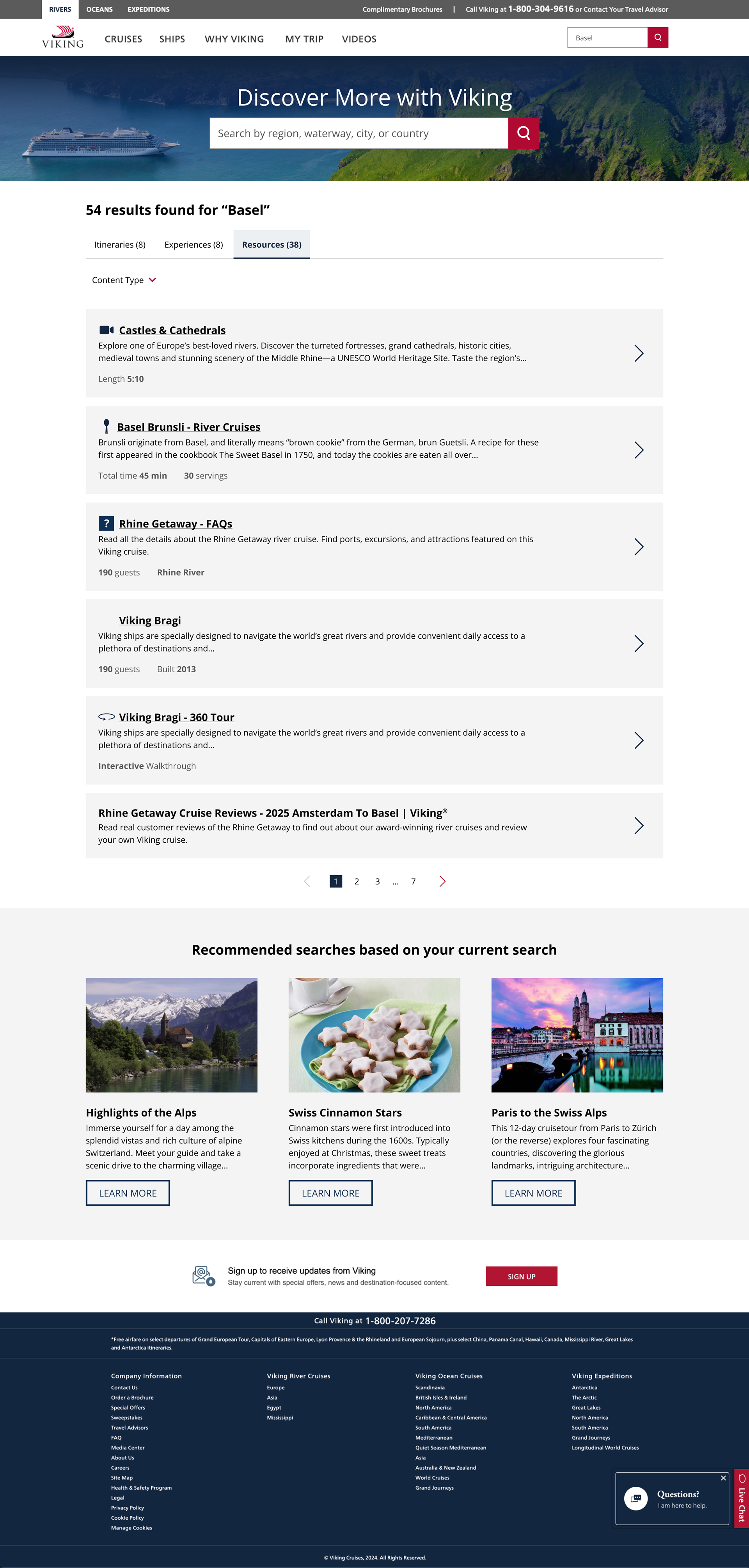
Resources Based Results
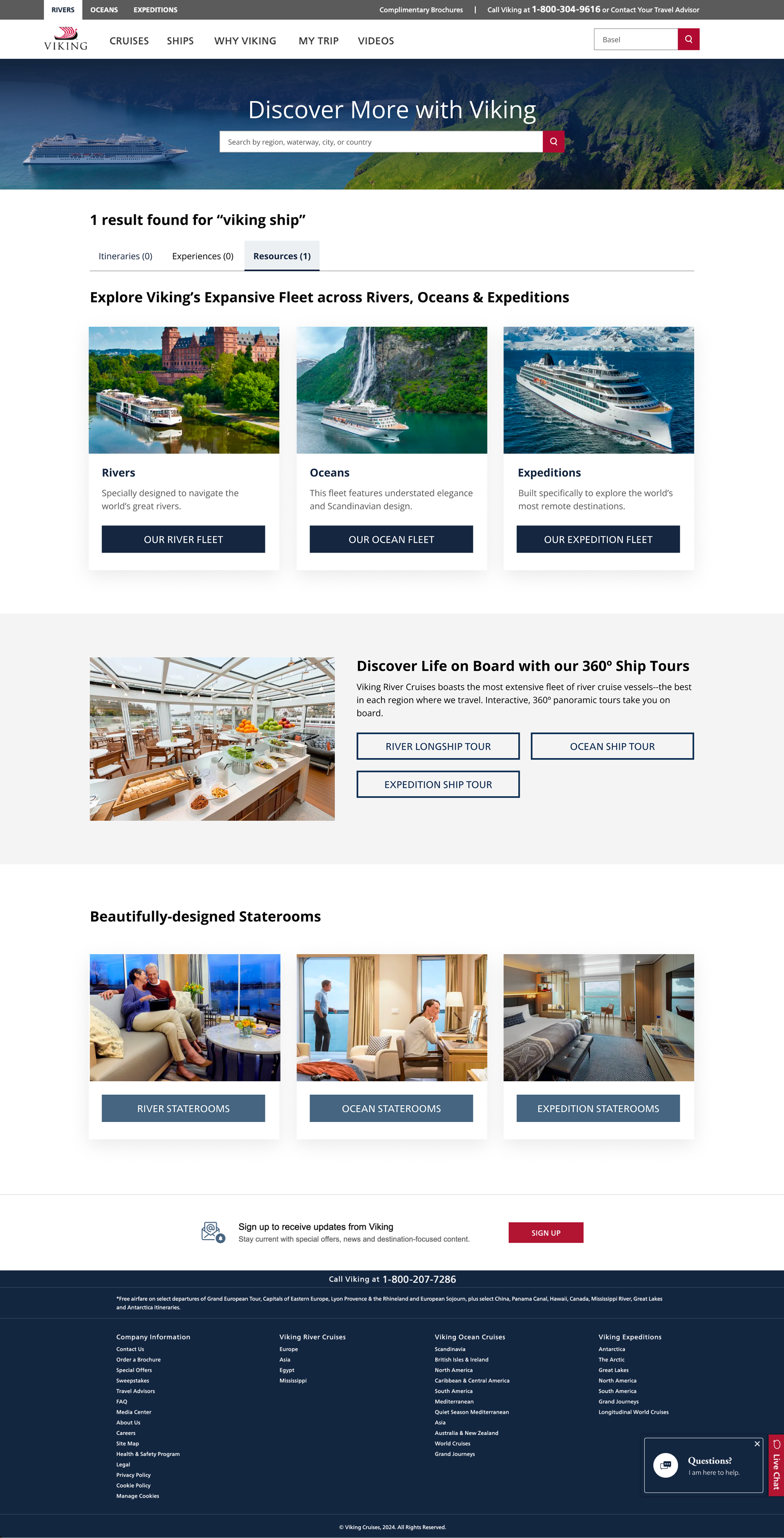
Specific Keyword Results
Healing The Pain Points
Lack of Intuitive Search
Solution: We implemented an enhanced search bar with auto-suggestions and predictive text. Utilizing natural language processing (NLP) to understand user queries better. We also included a quick access section for frequently searched items like contact details, cruise details, and itinerary inclusions. Regularly update and optimize the search algorithm based on user behavior and feedback.
Destination-Based Itineraries Unavailable:
Solution: Introducing destination-based filtering options allows users to search for itineraries by destination, date, and type of cruise. Search results would be accompanied by interactive maps and visual aids to help users explore various destinations and available itineraries quickly.
Limited Filtering and Sorting Options:
Solution: Creating a proper filtering and sorting functionality to include more criteria such as price range, duration, amenities, experiences, destinations and resources for more specific search results. Additionally adding dynamic filters and keyword tags that allow users to refine their search results in real-time allows us to provide a clear and intuitive user interface and experience that Viking has never offered before.
Solution: We implemented an enhanced search bar with auto-suggestions and predictive text. Utilizing natural language processing (NLP) to understand user queries better. We also included a quick access section for frequently searched items like contact details, cruise details, and itinerary inclusions. Regularly update and optimize the search algorithm based on user behavior and feedback.
Destination-Based Itineraries Unavailable:
Solution: Introducing destination-based filtering options allows users to search for itineraries by destination, date, and type of cruise. Search results would be accompanied by interactive maps and visual aids to help users explore various destinations and available itineraries quickly.
Limited Filtering and Sorting Options:
Solution: Creating a proper filtering and sorting functionality to include more criteria such as price range, duration, amenities, experiences, destinations and resources for more specific search results. Additionally adding dynamic filters and keyword tags that allow users to refine their search results in real-time allows us to provide a clear and intuitive user interface and experience that Viking has never offered before.
Insufficient Resources for Different User Types:
Solution: Resources were a huge pain point in the old search experience due to a dated search engine and keyword database. Utilizing SearchGPT we were able to enhance our database custom-tailored from Viking Cruises marketing website content and guides for different user personas, such as new guests, past guests, 3rd party & travel agency guests or those seeking resources from external links. We Implemented a dedicated help center with FAQs, tutorials, and live chat support for quick assistance along with bespoke pages that become more intuitive as more users interact with the new search experience features.
Inadequate Destination Information:
Solution: Develop comprehensive destination guides that include detailed information about each location, such as popular attractions, local culture, weather, and travel tips. Integrate user-generated content like reviews, photos, and travel experiences to enrich the information. Ensure this content is easily accessible through the search functionality and relevant pages.
Conclusion
Solving for these pain points allowed us to enhance our information architecture to align better with user expectations, reduce dependency on customer support, and enhance overall usability. This data-driven approach ensures that the solutions are grounded in user needs and behaviors. Our Pre & Post user testing sessions were very informative and profound in the design process and will help us continue to shape & mold future enhancements of what we built.
Solution: Resources were a huge pain point in the old search experience due to a dated search engine and keyword database. Utilizing SearchGPT we were able to enhance our database custom-tailored from Viking Cruises marketing website content and guides for different user personas, such as new guests, past guests, 3rd party & travel agency guests or those seeking resources from external links. We Implemented a dedicated help center with FAQs, tutorials, and live chat support for quick assistance along with bespoke pages that become more intuitive as more users interact with the new search experience features.
Inadequate Destination Information:
Solution: Develop comprehensive destination guides that include detailed information about each location, such as popular attractions, local culture, weather, and travel tips. Integrate user-generated content like reviews, photos, and travel experiences to enrich the information. Ensure this content is easily accessible through the search functionality and relevant pages.
Conclusion
Solving for these pain points allowed us to enhance our information architecture to align better with user expectations, reduce dependency on customer support, and enhance overall usability. This data-driven approach ensures that the solutions are grounded in user needs and behaviors. Our Pre & Post user testing sessions were very informative and profound in the design process and will help us continue to shape & mold future enhancements of what we built.
Data Driven Outcome
In the first two months of launching our New Search Experience, we’ve seen immediate and significant results compared to the past two years of performance through our domain’s SEO equity. While we’ve achieved our initial goals, the journey is far from over. There are still exciting opportunities to enhance our search experience by making it even more intuitive and responsive. By focusing on users’ top searches, destination preferences, intricate keyword patterns, and custom cruise-related terms tailored to both new and returning guests, we can continue to elevate the experience for all users.
In the first two months of launching our New Search Experience, we’ve seen immediate and significant results compared to the past two years of performance through our domain’s SEO equity. While we’ve achieved our initial goals, the journey is far from over. There are still exciting opportunities to enhance our search experience by making it even more intuitive and responsive. By focusing on users’ top searches, destination preferences, intricate keyword patterns, and custom cruise-related terms tailored to both new and returning guests, we can continue to elevate the experience for all users.

